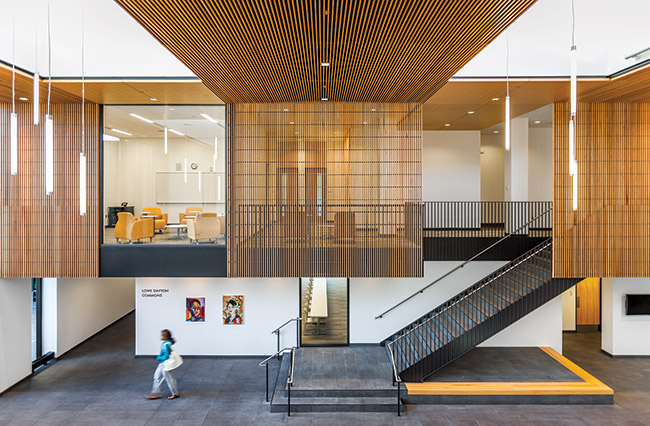Janet Wallace Fine Arts Center
Artistic license: A Minneapolis-based firm transforms a tired Brutalist structure into a state-of-the-art facility and a vibrant campus hub.




























Architects & Firms
St. Paul
In developing the ceramic facade for a revamped studio-art wing for Macalester College’s Janet Wallace Fine Arts Center, the architects at Minneapolis-based firm HGA started to feel as if they had enrolled in an art class of their own. For four months, they worked with a terra-cotta manufacturer, experimenting with different clays and glazes to get the desired hues—a warm spectrum of burnt red, gray, beige, and brown—just right. The firm would receive a batch of freshly fired samples every few weeks that soon began to pile up in the office.
The labor-intensive process paid off, as is evident in the resulting facade, a rhythmic composition of terra-cotta fins. It also embodies the design approach that HGA took throughout the $63 million multi-phase renovation of the center’s studio-art facility, a campus commons, and an adjacent music wing. “We wanted to express the art happening in the building to the rest of the campus,” says project manager Rebecca Celis.
When the Janet Wallace Fine Arts Center first opened, in 1965, it was one of the country’s premier art facilities, thanks to a generous personal donation from DeWitt and Lila Wallace, cofounders of the Readers Digest magazine empire. (DeWitt’s father was an early president of the college; Janet was his mother.) The original Brutalist complex—designed by Boston-based firm Perry, Shaw, Hepburn & Dean—was composed of four volumes devoted to theater and dance, music, humanities, and visual arts, connected by a central art gallery and interspersed with outdoor courtyards.
But time and the changing needs of Macalester made it clear the art and music facilities were no longer adequate: galleries, studios, and practice spaces were lightless and claustrophobic; the exterior leaked; and the midcentury-era boiler and chiller facilities—which supported the entire campus—needed an overhauling.
In spite of the poor condition of this half of the Janet Wallace complex (the existing theater and humanities wings are being maintained for now), a teardown didn’t seem right, in terms of design and economics. “As we began to look at the existing building and spaces, it made much more sense to renovate. Each one was a different puzzle,” says Tim Carl, the lead project designer and CEO of HGA.
The terra-cotta-wrapped studio-arts wing marked the culmination of that puzzle. Completed in January 2014, the renovated 27,000-square-foot building, with a new steel-framed third floor, branches off from a new central student commons. While the terra-cotta rainscreen was treated as an artwork, the architects wanted the interiors to have a more industrial feel, with exposed ductwork and simple finishes to accommodate the heavy-duty equipment inside, including fume hoods, a foundry, kilns, and a ceiling crane system. The updated facility contains separate state-of-the-art work areas for sculpture, ceramics, painting, and print-making.
While the studio art spaces are straightforward, interior drama can be found in an earlier phase of the renovation, completed in 2012. Here HGA created a new arts commons on the site of the old central gallery. Students enter an airy, double-height atrium, which is punctuated by light monitors with clerestory glazing and lined with slatted screens of red oak. The wood addresses acoustic concerns, while glass openings illuminate interior spaces and enable occupants to see activities inside the building as well as out to the surrounding campus.
Extending to the west of this commons is a renovated music block, which includes 51,000 square feet of new construction containing practice space for both full ensembles and individual musicians. At the music wing’s heart is a dramatic 318-seat concert hall. Working with consultants Acoustic Distinctions, the architects removed a balcony and added an undulating red oak screen over acoustic curtains to modulate sound.
The transformation of the Janet Wallace Fine Arts Center has been successful in the eyes of both Macalester’s administration and the architecture community (the studio-art phase received a 2014 AIA Minnesota honor award). As soon as funding is available, the college will embark on a third stage to renovate the theater and humanities wings.
Ultimately, it’s the student life within that is providing the alchemy that finally completes the architecture. On a tour of the building, the architects peered into a senior art studio. It was in happy disarray, with a motley assortment of chairs and sofas, heaps of art supplies and books, and a life-size effigy of a character from the animated film Spirited Away leering through one of the substantial windows. Carl looked admiringly at the clutter: “It’s so much better now.”
Size: 57,000 square feet, renovation; 51,000 square feet, new construction (phase I); 27,000 square feet, renovation; 7,000 square feet, new construction (phase II)
Cost: $37.2 million (phase I); $25.7 million (phase II)
Completion Date: August 2012 (phase I); January 2014 (phase II)
PeopleClient/Owner: Macalester College
Architect:
Personnel in architect's firm who should receive special credit:
Interior designer:
Engineers:
Mechanical Engineer:
Electrical Engineer: Consultant(s):
Landscape:
Lighting:
Theatrical:
Acoustical:
General contractor:
Photographer(s): |
Products
Structural system
Exterior cladding Metal Panels: Dark Anodized Aluminum Metal Panel / MG McGrath Glass curtain wall: EFCO System 5500 Rainscreen: Boston Valley Terra Cotta / McGough Install Precast concrete: Hanson Precast hollow core plank Custom Millwork: Aaron Carlson
Roofing Metal: Firestone Flashings & Roof Caps
Windows
Glazing Skylights: Viracon VNE1-63 and VE15-2M
Doors Metal doors: Steelcraft Wood doors: Algoma Special doors (sound control): Security Metal Products
Hardware Closers: LCN Exit devices: Von Durpin Pulls: Hiawatha Security devices: Schlage Electronics Other special hardware: Cores - Best; Sound Seals - Reese
Interior finishes Suspension grid: Armstrong Cabinetwork and custom woodwork: Artifex Millwork Paints and stains: Superior Painting PPG Products Plastic laminate: Laminart, Nevamar Solid surfacing: Corian
Floor and wall tile: Resilient flooring: Forbo Carpet: Shaw Contract
Furnishings Fixed seating: Irwin Seating (Concert Hall) Chairs: HBF, Allermuir, Stylex, Krug, Jack Cartwright, Leland Tables: HBF Upholstery: Arc Com, Knoll, Sina Pearson, HBF Textiles, Architex, Momentum, Design Tex
Lighting
Conveyance
Energy |
















